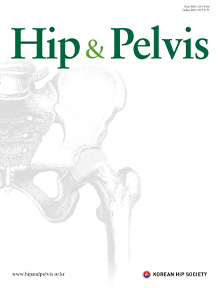Quick links
Related article in
-
Original ArticleMarch 31, 2022
 0
0
 139
139
 39
39

The Short-term Outcomes of Physiotherapy for Patients with Acetabular Labral Tears: An Analysis according to Severity of Injury in Magnetic Resonance Imaging
Makoto Kawai, PT, MSc*,†
Hip Pelvis 2022; 34(1): 45-55 , Kenji Tateda, MD, PhD‡, Yuma Ikeda, PT, MSc*, Ima Kosukegawa, MD, PhD‡, Satoshi Nagoya, MD, PhD§, Masaki Katayose, PT, PhD*,†AbstractPurpose: The aim of this study was to evaluate the short-term outcome of physiotherapy in patients with acetabular labral tears and to assess the effectiveness of physiotherapy according to the severity of the labral tear.
, Kenji Tateda, MD, PhD‡, Yuma Ikeda, PT, MSc*, Ima Kosukegawa, MD, PhD‡, Satoshi Nagoya, MD, PhD§, Masaki Katayose, PT, PhD*,†AbstractPurpose: The aim of this study was to evaluate the short-term outcome of physiotherapy in patients with acetabular labral tears and to assess the effectiveness of physiotherapy according to the severity of the labral tear.
Materials and Methods: Thirty-five patients who underwent physiotherapy for treatment of symptomatic acetabular labral tears were enrolled. We evaluated the severity of the acetabular labral tears, which were classified based on the Czerny classification system using 3-T MRI. Clinical findings of microinstability and extra-articular pathologies of the hip joint were also examined. The International Hip Outcome Tool 12 (iHOT12) was use for evaluation of outcome scores pre- and post-intervention.
Results: The mean iHOT12 score showed significant improvement from 44.0 to 73.6 in 4.7 months. Compared with pre-intervention scores, significantly higher post-intervention iHOT12 scores were observed for Czerny stages I and II tears (all P<0.01). However, no significant difference was observed between pre-intervention and post-intervention iHOT12 scores for stage III tears (P=0.061). In addition, seven patients (20.0%) had positive microinstability findings and 22 patients (62.9%) had findings of extra-articular pathologies. Of the 35 patients, eight patients (22.9%) underwent surgical treatment after failure of conservative management; four of these patients had Czerny stage III tears.
Conclusion: The iHOT12 score of patients with acetabular labral tears was significantly improved by physiotherapy in the short-term period. Improvement of the clinical score by physiotherapy may be poor in patients with severe acetabular labral tears. Determining the severity of acetabular labral tears can be useful in determining treatment strategies. -
Review ArticleJune 1, 2011
 0
0
 63
63
 17
17
Anterior Approaches in Hip Surgery
Tae-Young Kim, MD, Seung-Hwan Cha, MD, Otgonbayar Maidar, MD, Sang-Soo Lee, MD
J Korean Hip Soc 2011; 23(2): 95-102AbstractThe Smith-Petersen anterior approach and the Watson-Jones anterolateral approach are the two most renowned anterior approaches for hip surgery. The anterior approach offers several advantages, including a reduced dislocation risk as compared with that associated with the posterior approach. The post-operative dislocation rate after total hip arthroplasty is known to be 2~3 times lower than that of the posterior approach. However, a more extensive skin incision and poor anatomical visualization are some of the disadvantages of the anterior approach. Nevertheless, since this approach preserves the circulation to the femoral head, the ability to perform the anterior approach is imperative for hip surgeons.
- 1

Vol.36 No.1
Mar 01, 2024, pp. 1~75
Most Keyword
?
What is Most Keyword?
- It is most registrated keyword in articles at this journal during for 2 years.
Most View
-
Pathophysiology and Treatment of Gout Arthritis; including Gout Arthritis of Hip Joint: A Literature Review
Yonghan Cha, MD
Hip Pelvis 2024; 36(1): 1-11 , Jongwon Lee, MD
, Jongwon Lee, MD  , Wonsik Choy, MD
, Wonsik Choy, MD  , Jae Sun Lee, PhD*,†
, Jae Sun Lee, PhD*,†  , Hyun Hee Lee, MD‡
, Hyun Hee Lee, MD‡  , Dong-Sik Chae, MD‡
, Dong-Sik Chae, MD‡ 
-
Treatment of Osteoporosis after Hip Fracture: Survey of the Korean Hip Society
Jung-Wee Park, MD
Hip Pelvis 2024; 36(1): 62-69 , Je-Hyun Yoo, MD*
, Je-Hyun Yoo, MD*  , Young-Kyun Lee, MD
, Young-Kyun Lee, MD  , Jong-Seok Park, MD†
, Jong-Seok Park, MD†  , Ye-Yeon Won, MD‡
, Ye-Yeon Won, MD‡ 
Editorial Office
Laboratory tests performed in hip fracture patients. CTX: carboxy-terminal telopeptide of collagen I, PTH: parathyroid hormone, P1NP: procollagen type I N propeptide, U/A: urinalysis.|@|~(^,^)~|@|First-line treatment option for osteoporosis in hip fracture patients. BP: bisphosphonate, PTH: parathyroid hormone, SERM: selective estrogen receptor modulator.|@|~(^,^)~|@|Osteoporosis medication in patients with rebound phenomenon after cessation of denosumab. Ca+Vit. D: calcium and vitamin D, PTH: parathyroid hormone, SERM: selective estrogen receptor modulator.|@|~(^,^)~|@|The most important recognized factor for atypical femoral fracture.|@|~(^,^)~|@|Preferred osteoporosis medications after cessation of bisphosphonate in patients with atypical femoral fracture. PTH: parathyroid hormone, Ca+Vit. D: calcium and vitamin D, SERM: selective estrogen receptor modulator.|@|~(^,^)~|@|Preferred osteoporosis medications in patients with high-risk of atypical femoral fracture. Ca+Vit. D: calcium and vitamin D, SERM: selective estrogen receptor modulator, PTH: parathyroid hormone.
Hip Pelvis 2024;36:62~69 https://doi.org/10.5371/hp.2024.36.1.62
© H&P
© 2024. The Korean Hip Society. Powered by INFOrang Co., Ltd




 Cite
Cite PDF
PDF



